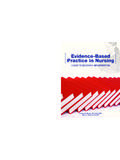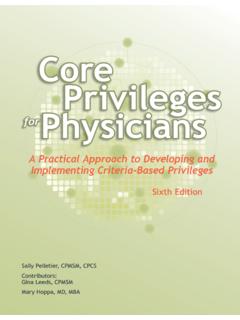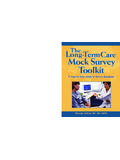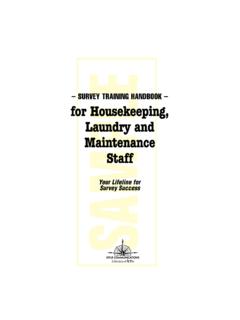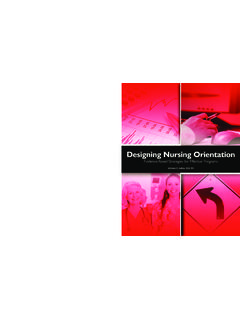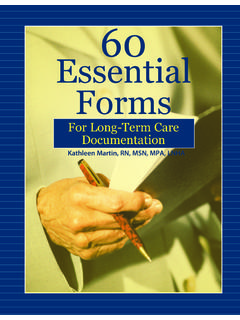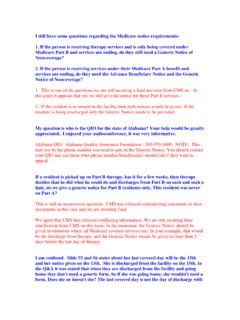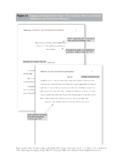Transcription of Inservice - hcmarketplace.com
1 InserviceTraining GuideInserviceTraining GuideStrategies for Effective Long-Term Care Staff EducationStrategies for Effective Long-Term Care Staff EducationKelly Smith Papa, RN, BSNI nservIce TraInIng guIde: sTraTegIes for effecTI ve Long-Term care sTaff educaTI on About the Author ..viPreface ..viiIntroduction ..xWhat is an Inservice ? ..xi Chapter One: Traditional inservices .. Traditional inservices ..3 Encouraging attendance ..4 Inservice openings ..4 Timing ..5 Inservice teaching methods ..5 Questions as a teaching method ..5 Remembering your audience ..6 Storytelling ..6 Video presentations ..7 Demonstrations ..7 Games ..8 PowerPoint presentations ..9 Evaluating learning ..9 Program evaluation ..10 Chapter Two: Informal inservices .. Walking inservices ..13On-the-spot inservices ..14 Contents Inservice TraInIng guIde: sTraTegIes for effecTI ve Long-Term care sTaff educaTI onco nT e nT sQuick inservices.
2 14 Readable inservices ..15 Skills fairs ..16 Payday inservices ..16 Bathroom and breakrooms ..16 Staff-requested inservices ..17 Mock situation inservices ..19 Personal inservices ..19 Chapter Three: Inservice tools and methods .. Documentation ..23 Binders ..23 Timely topics ..24 Resources ..25 Forming relationships with staff members ..26 Cultural diversity ..26 Dealing with staff complaints ..27 Personal appearance ..28 Learning styles ..28 Educational accessories ..29 Mandatory inservices ..29 Themes ..30 Prizes and gifts ..30 Poetry and songs ..31 Humor ..31 Food and candy ..32 Advertising your Inservice ..32 Inservice calendars and scheduling inservices ..34 Inservice invitations ..36 Photographs ..36 Tools of the trade ..37 Guest speakers ..37 Bulletin boards ..38 Teaching environment ..38 Inservice TraInIng guIde: sTraTegIes for effecTI ve Long-Term care sTaff educaTI on co nT e nT sLife skills.
3 39 Quality committees ..40 Dressing up ..41 Celebrations ..41 Chapter Four: Inspection preparation and policy enforcement ..4 Inservices and inspections ..45 Inspection readiness committees ..46 Facility policies and procedures ..46 Spot checks ..47 Post-inspection inservices ..48 Chapter Five: Orientation ..49 Interviews ..51 Greeting and welcoming new employees ..51 Engage your audience ..52 Orientation handouts ..53 Different types of new employees ..53 Follow-up to orientation ..54 Chapter Six: Conclusion ..55 Frequency ..57 Persistence ..58 Have fun! ..58 Traditional inservicesC h a p t e r O n eInservIce TraInIng guIde: sTraTegIes for effecTI ve Long-Term care sTaff educaTI on Traditional inservicesThe most common method of Inservice delivery is the formal, preplanned Inservice . Staff is made aware of the Inservice topic, date, time, and location, all of which the staff development nurse determines and prepares well in advance.
4 Inservice topics often incor-porate basic care skills, new research developments, diagnoses, quality needs, changes, problems in the facility, or facility policies and procedures. They may include skin care protocols, pharmaceutical updates, unusual diagnoses or surgical procedures, wound care management, and fall prevention. In addition to creating these themselves, staff development nurses can also purchase entire inservices from health care education com-panies. These purchased inservices can be developed to include topic areas specific to the facility. An Inservice includes the objectives to be covered, opening activities, the body of infor-mation, an activity or game, a post-test to assess if objectives were met, and a program evaluation for future Inservice developments. If you create your own Inservice , you will need to identify the problem, the goal, and the teaching approaches. Like a care plan, an Inservice must be tailored to the facility, staff, and residents.
5 The traditional Inservice format is the primary method of delivering mandatory inservices. Check with your facility policies, state regulations, and federal OSHA, JCAHO, and any other accreditation requirements for yearly mandatory inservices. Topics may include abuse prevention, patients rights, HIPAA, fire safety, infection control, cultural diversity, age specific care, and pain management. Develop a yearly and a monthly Inservice cal-endar to ensure that all required inservices are scheduled within the year. In addition, Traditional inservicesch a pT e r on emake sure that staff are aware of which inservices are mandatory and try to reserve the term mandatory for required inservices. Encouraging attendancePrior to the Inservice , walk around the facility and personally ask staff members if they plan to attend. It is important to tell them you look forward to seeing them there, and to let them know a little about the Inservice to get them excited about it.
6 If they are unable to attend the Inservice when it s being held, ask if they can come to the next one or if they d like you to give them some handouts or a video to watch later. It is important for staff to know that you are committed to get-ting them the information when it is convenient for them. Do not be pushy, but assure staff that you will be there when they are ready. To grab attention, wear a hat that relates to your Inservice topic as you pass out personal invitations to the upcoming Inservice . Use bright posters to adver-tise in the break room or near the time openingsAt the Inservice opening, when staff first begin to arrive, gather staff and begin the Inservice . Greet staff as they arrive to the classroom and thank them for attending. At this time, you can set up, pass out handouts and other materials, have staff sign an attendance sheet, and offer refresh-ments. It is important for staff to know that inservices will start on time.
7 Staff development nurses should never be late to a scheduled Inservice , or staff may feel devalued or that they do not need to be on time the beginning of the Inservice , state the event s objectives. Depending on the Inservice topic and the staff in attendance, begin the Inservice by either formally stating a few objectives of the Inservice or informally asking staff to share their objectives for the Inservice . This introduction serves as an opportunity to ask staff if they have ideas or questions about the Inservice topic. If staff list questions at the beginning of an Inservice , you will be able to quickly determine how to make the Inservice more relevant to them. Inservice TraInIng guIde: sTraTegIes for effecTI ve Long-Term care sTaff educaTI onch a pT e r on eConsider asking one staff member to record the questions on a piece of paper or on a board to be reviewed during or at the end of the Inservice . As another option, questions may be held until the end of the Inservice , or staff can ask their questions as they arise during the Inservice .
8 Some staff may know the answers to the questions; the staff development nurse chooses whether to answer questions himself or herself or to allow other staff to do so, thereby recognizing staff a time limit for the Inservice ahead of time so that staff do not become restless wondering when it will end. Time limits should always be adhered to, as inservices are typically worked into busy clinical schedules. Keep the Inservice as short as possible, and staff will appreciate that you have valued their time. Ideally, a lecture should last 20-40 minutes, with an additional ten min-utes allotted for a game, question period, or teaching methodsThe Inservice may involve a lecture, posters, videos, handouts, demonstrations, games, or discus-sions. For most inservices, the essential information should be delivered in the form of a lecture, which allows it to be clearly outlined and thoroughly explained. Your presentation can also be multisensory, featuring overheads, and music.
9 Food is another great way to incorporate senses into your presentation. The most effective method will depend on the topic, the staff in atten-dance, and the need for return demonstrations. For instance if your group is small, you may want to sit with participants and encourage open discussion of the topic being inserviced, encouraging them to ask questions. For a larger group, you may need to ask staff to hold their questions until the end of the presentation. Questions as a teaching methodTraditional lectures can cause your staff to feel disengaged from the topic, so try alternatives. Your staff will appreciate your creativity, boosting Inservice attendance and staff attention during the Inservice . A good option is to ask questions at critical points during your lecture. This allows staff to pull from their own experiences and will help ensure maximum participation, especially Inservice TraInIng guIde: sTraTegIes for effecTI ve Long-Term care sTaff educaTI on Tr a dI T Io n aL In s e r vI c e sif the questions are open ended or have multiple answers.
10 For example, ask staff what could be used as alternatives to restraints or how to prevent combative behaviors. Start with a few example answers to give your audience a sense of what you are looking for. You can also encourage participation by offering a participation ticket each time someone par-ticipates in the discussion. At the end of the Inservice , have staff write their names on the backs of their tickets, and then collect all tickets to use in a prize drawing. Prizes can be distributed creatively, perhaps wrapped in gift wrap or chosen by the winner, and can include free promo-tional material. Remembering your audienceThe language used in an Inservice needs to be appropriate to the staff in attendance. Keep in mind the different educational levels of staff when lecturing. Do not talk down to the staff in attendance; they came to learn from you, not to be embarrassed or made uncomfortable. Some nonclinical staff members may not know what an immune system is, for example, but may feel uncomfortable asking you to define it.
